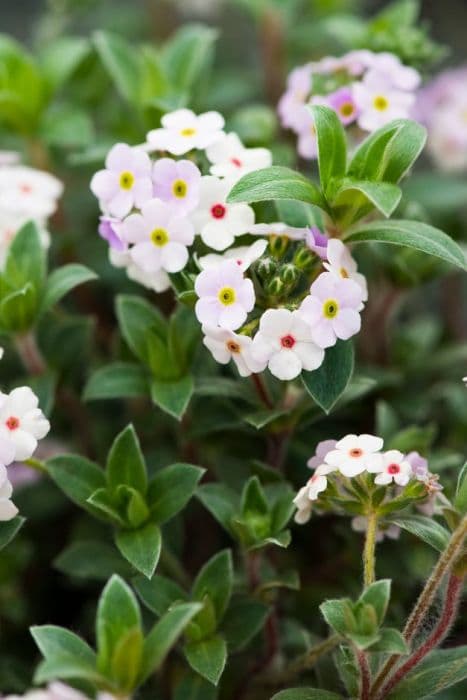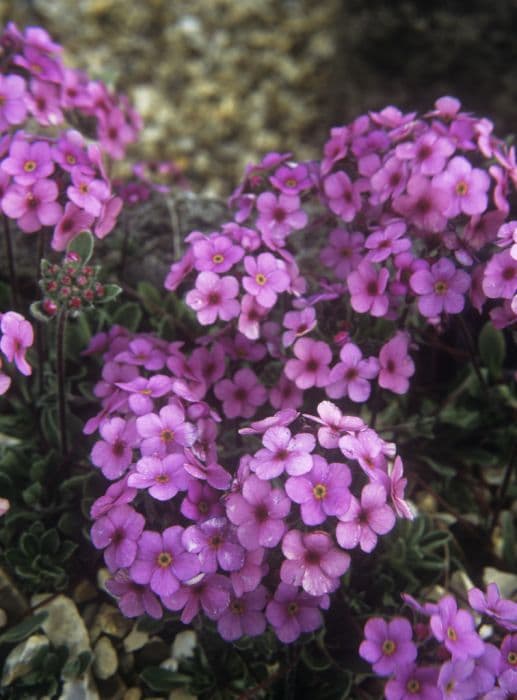Eastern cyclamen Cyclamen coum subsp. coum f. coum Silver Group

ABOUT
Cyclamen coum subsp. coum f. coum Silver Group, also called Cyclamen, presents a charming display with its distinctive foliage and blossoms. The leaves are notable for their attractive, silver-patterned decorative markings, often heart-shaped with a green edge defining their border. The foliage itself provides a lush backdrop to the showy flowers that stand above it on slender stems. The flowers of this Cyclamen are delicate and shape into a refined, upswept form, resembling a sweeping bonnet or small butterfly wings. They exhibit a variety of colors, ranging from deep pinks to purples and sometimes even whites, with each petal characterized by a darker, magenta blotch at the base, which add an intricate touch to the overall appearance of the flower. This particular variety blooms typically during the winter months, brightening up the darker days with its vivid blooms. The plant's aesthetic is further enhanced when it forms clusters, creating a carpet of silver foliage and vibrant flowers, which make it particularly prized for its ornamental value in garden settings and as a part of a collection among enthusiasts.
About this plant
 Names
NamesFamily
Primulaceae.
Synonyms
Eastern Cyclamen, Round-leaved Cyclamen, Silverleaf Cyclamen.
Common names
Cyclamen coum subsp. coum f. coum Silver Group.
 Toxicity
ToxicityTo humans
Cyclamen, which includes the Cyclamen coum subsp. coum f. coum Silver Group, contains saponins that can be toxic if ingested. Ingesting any part of the plant can lead to symptoms such as nausea, vomiting, and diarrhea. In severe cases, ingestion can result in heart rhythm abnormalities, seizures, and even death if consumed in large quantities.
To pets
Cyclamen is also toxic to pets such as cats and dogs, with similar effects due to the saponins it contains. If pets ingest any part of the plant, they may experience symptoms like vomiting, diarrhea, and salivation. In severe cases, cyclamen ingestion can lead to seizures, cardiac abnormalities, and could be fatal without prompt veterinary care.
 Characteristics
CharacteristicsLife cycle
Perennials
Foliage type
Evergreen
Color of leaves
Variegated
Flower color
Pink
Height
3-4 inches (7.62-10.16 cm)
Spread
6 inches (15.24 cm)
Plant type
Bulb
Hardiness zones
5
Native area
Mediterranean
Benefits
 General Benefits
General Benefits- Aesthetic Appeal - Adds vibrant color and unique silver-variegated foliage to gardens or indoor spaces.
- Seasonal Interest - Blooms in late winter to early spring, providing cheer and color when few other plants flower.
- Attracts Pollinators - Flowers can attract bees and other beneficial insects, supporting local ecosystems.
- Compact Size - Suitable for small gardens or containers, making it versatile for various gardening projects.
- Low Maintenance - Requires minimal care once established, ideal for novice gardeners or those with limited time.
- Drought Tolerance - Once established, it has a level of drought tolerance, reducing the need for frequent watering.
- Deer and Rabbit Resistance - Generally resistant to grazing by deer and rabbits, which can be beneficial in prone areas.
 Medical Properties
Medical PropertiesThis plant is not used for medical purposes.
 Air-purifying Qualities
Air-purifying QualitiesThis plant is not specifically known for air purifying qualities.
 Other Uses
Other Uses- Cyclamen coum, due to its vibrant colors, can be used as a natural dye for fabrics, offering hues from pale pink to a deeper magenta depending on the concentration.
- The tubers of Cyclamen were historically used as a soap substitute, as they contain saponins, which can create a soap-like lather when mixed with water.
- In arts and crafts, the distinctive heart-shaped leaves of Cyclamen coum can be pressed and incorporated into botanical paper making or for decorative motifs in handmade paper products.
- The cyclamen flower can be a muse for artists and photographers, inspiring cyclamen-themed artwork, paintings, and photographic collections due to its unique beauty.
- The dried petals of Cyclamen coum can be used in potpourri mixtures, adding a delicate touch to homemade aromatic blends.
- Since Cyclamen coum is a symbol of love and tenderness in the language of flowers, they can be integrated into wedding decorations or bouquets to convey a message of deep affection.
- Cyclamen's patterned foliage can be used in garden design to create contrasting textures or to establish a visually appealing groundcover under trees and shrubs.
- Due to its compact growth habit, Cyclamen coum is suitable for container gardening, allowing urban gardeners to enjoy its blooms on balconies and small patios.
- The vibrant flowers of Cyclamen coum can be used as a natural food coloring for desserts, although care should be taken as parts of the plant are toxic when consumed in large quantities.
- In folklore, Cyclamen coum was believed to bring luck and protection, and it was sometimes planted around homes and gardens to ward off negative energies and misfortune.
Interesting Facts
 Feng Shui
Feng ShuiCyclamen is not used in Feng Shui practice.
 Zodiac Sign Compitability
Zodiac Sign CompitabilityCyclamen is not used in astrology practice.
 Plant Symbolism
Plant Symbolism- Love and Devotion: Cyclamen often symbolizes sincere affection and enduring love, making it a popular gift for partners and loved ones.
- Resignation and Goodbye: Because cyclamen naturally goes dormant, it can represent a farewell or resignation, symbolizing a departure or end of a relationship.
- Deep Sentiments: The rich color and shape of cyclamen blossoms are thought to reflect deep emotions and can be used to convey heartfelt sentiment.
 Water
WaterThe Eastern Cyclamen needs to be watered when the topsoil feels dry to the touch, typically once every 1 to 2 weeks, depending on the ambient humidity and temperature. Provide enough water to moisten the soil throughout the pot but ensure that any excess water can drain away to prevent waterlogging, which can cause root rot. During the dormant period, after the leaves have died back, reduce watering significantly, perhaps to just a few ounces every month, to keep the tuber from drying out completely.
 Light
LightThe Eastern Cyclamen prefers bright, indirect light, so placing it in an east or north-facing window would be ideal. Direct sunlight can scorch the leaves, while too little light can cause leggy growth. Ensure the plant is protected from the hot midday sun, especially during the summer months.
 Temperature
TemperatureThe Eastern Cyclamen thrives in temperatures between 50°F and 68°F. It can survive a minimum temperature of around 40°F during its dormant period, but should not be subjected to temperatures below freezing. Ideally, maintain the temperature within the growth range to promote healthy foliage and flowering.
 Pruning
PruningPruning the Eastern Cyclamen is generally not necessary except to remove yellow or dead leaves to maintain the plant's appearance and health. Prune these leaves at the base with sterile scissors or by gently pulling them off, typically after flowering has finished, to prepare the plant for its dormant period.
 Cleaning
CleaningAs needed
 Soil
SoilCyclamen, or the Persian violet, thrives best in well-draining, humus-rich soil with a slightly acidic to neutral pH of around 6.5 to 7.0. An ideal soil mix for cyclamen includes equal parts of potting soil, perlite, and peat or leaf mold to ensure proper drainage and aeration.
 Repotting
RepottingCyclamen, generally referred to as the Persian violet, should be repotted every couple of years or when the tuber has outgrown its pot. It's best done when the plant is dormant, typically in late summer before the new growth cycle begins.
 Humidity & Misting
Humidity & MistingCyclamen, commonly known as Persian violets, prefer high humidity levels, around 50-70%. However, they should not be subjected to wet foliage, so a pebble tray with water beneath the pot can increase ambient humidity without causing excess moisture on the leaves.
 Suitable locations
Suitable locationsIndoor
For Persian violets indoors, keep in bright, indirect light and cool temps.
Outdoor
Grow Persian violets outdoor in dappled shade, sheltered from strong wind.
Hardiness zone
5-9 USDA
 Life cycle
Life cycleCyclamen coum, also known as Eastern cyclamen, starts its life cycle as a seed, which germinates in the spring to produce a small tuber. The tuber undergoes a period of dormancy during the hot summer months. In the autumn, the tuber awakens, and foliage begins to grow, forming heart-shaped leaves that are often silver-patterned, characteristic of the Silver Group. During winter, it blooms with small, upward-facing flowers, which can range in color from white to deep pink. After flowering, the plant sets seed, which is distributed naturally, often by ants attracted to the seed’s fleshy coating. As temperatures rise into summer, the above-ground foliage dies back, and the cyclamen enters dormancy again until the cooler temperatures of autumn stimulate the next growth cycle.
 Propogation
PropogationPropogation time
Spring to summer
Cyclamen coum, commonly known as Eastern Cyclamen, is often propagated by seed. The best time to sow Cyclamen seeds is when they are fresh, typically immediately after they are collected in late spring to early summer. To propagate by seed, you should sow the seeds in a tray filled with a well-draining soil mix. Cover the seeds with a very thin layer of soil or vermiculite as they require darkness for germination. Keep the tray in a cool place; the ideal temperature for germination is between 60-65°F (15-18°C). It can take several weeks to months for Cyclamen seeds to germinate, and patience is vital with this method. Once seedlings have developed a few true leaves, they can be carefully transplanted into individual pots.









